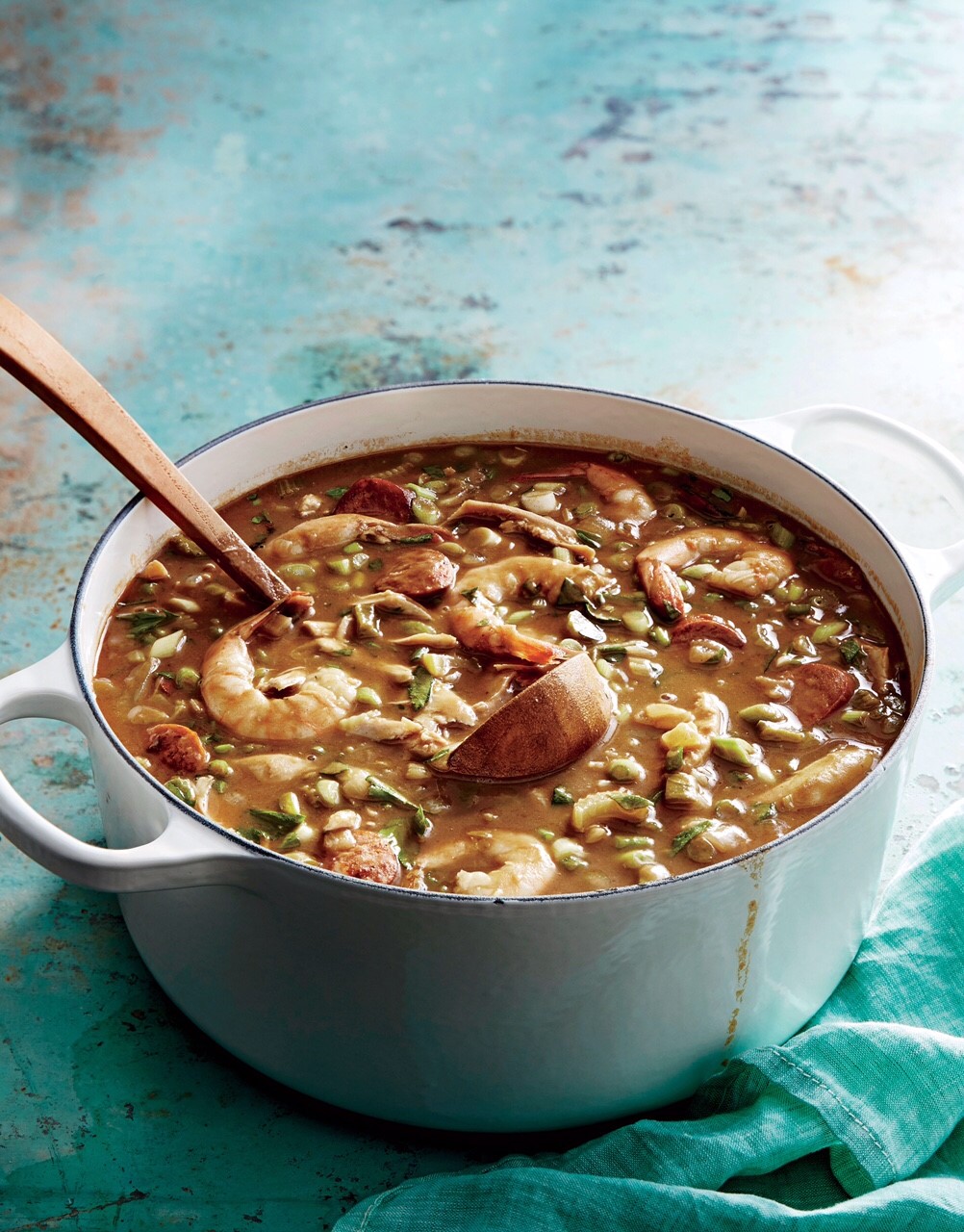
This recipe uses ingredients that are readily available in the winter time: oysters and andouille sausage, a Gulf Coast staple for making gumbos and jambalayas. Pronounced “ahn-doo-eee,” this is a heavily smoked pork sausage with French origins; I like the Cajun version that is also spicy and fragrant. It is important to get the roux as dark as you can, resulting in toasted nutty flavor. Combined with sausage and the seafood, the aroma and flavor is absolutely heavenly, especially on a cold winter day. *Note to LB-make comment about how the aroma is part of the experience.
LULU’S WINTER GUMBO
25 Cups
Ingredients
- Meat from a whole chicken that has been cooked with skin and bones discarded, approximately 2 pounds
- 1 pound of andouille sausage or any good quality smoked sausage
- 2 large onions, coarsely chopped
- 2 green peppers, coarsely chopped
- 1 medium head celery, coarsely chopped including leaves
- ¾ cup vegetable oil or bacon grease
- 1 cup all purpose flour
- 8 cups chicken broth, heated
- 3 teaspoons salt
- 2 teaspoons black pepper
- 1 tablespoons dried thyme
- 4 bay leaves
- 1 teaspoon dried oregano
- ½ t teaspoon dried sage
- 1 tablespoon LuLu’s Creola Seasoning Mix or any Creole seasoning
- 2 tablespoons Worcestershire sauce
- 2 cups, finely chopped green onions
- ½ cup fresh parsley, washed well and finely chopped
- 1 quart fresh oysters, drained
- 2 pounds medium shrimp, peeled and de-veined
- ¼ cup LuLu’s Perfect Pepper Sauce or any “medium hot” hot sauce (optional)
- File’ powder (optional)
Instructions
- Chop chicken meat into large bite-size pieces. Set aside.
- Cut sausage into thin round slices about 1/8 inch thick. In a cast iron or heavy skillet, cook sausage over medium heat until browned. Remove with a slotted spoon to a plate covered with paper towels. Set sausage aside to drain on paper towels.
- Chop onions and place in a bowl. Set aside.
- Chop green peppers and celery; place in another bowl. Set aside.
- To make the roux: heat the vegetable oil or bacon grease in a large heavy stockpot (10 quart) over medium high heat. When oil is hot, gradually add flour whisking continuously. Continue to stir roux adjusting heat as necessary to keep from burning. This may take 25 to 35 minutes or until your arm feels like it is about to fall off and the roux is a dark mahogany color. Be careful, if the roux burns, you will have to start all over again!
- Carefully add chopped onions to roux and continue stirring with a large wooden spoon for 2 – 3 minutes. Onions will sizzle and steam when they hit the hot roux so caution is advised. All seasoned gumbo cooks have roux battle scars on one or both arms.
- Add green peppers and celery, continuing to stir constantly for another 2 – 3 minutes. The mixture should resemble a pot of black beans.
- Add chicken and sausage and stir well.
- Add heated stock.
- Add salt, black pepper, thyme, bay leaves, oregano, sage, and Creole seasoning. Stir well. Bring gumbo to a boil and continue boiling for 5 minutes. Then reduce heat to maintain a slow simmer uncovered for approximately 1 hour or an entire day. If gumbo gets too thick, add a little water. If it is too thin, continue to let it simmer uncovered. Because there is pork sausage in this gumbo, if any excess oil rises to the top, skim off as necessary.
- Gumbo is always better the second day it has been cooked, although I’ve never had a complaint when I served it the day I made it. At this point, you can cool the gumbo. Turn off the heat and let it sit for about 30 minutes. Then place pot, uncovered, in an empty sink. Fill the sink with water and ice around the stock pot. Stir every 15 minutes to move the liquid around to facilitate cooling. Gumbo will spoil if cooled improperly. At the restaurant, we have cooling cylinders that look like baseball bats that are frozen and placed in the middle of five gallon buckets. I accomplish this at home by filling an empty liter soda bottle almost to the top and freezing it. After I have put the pot in the ice bath, I place the frozen soda bottle in the middle of the gumbo so that it cools from the inside out. When completely cool, I refrigerate it uncovered.
- If you decide to do this, heat gumbo slowly to simmering. Otherwise, thirty minutes before serving, add green onions and parsley to gumbo. Cover and cook for 15 minutes. Add oysters and shrimp. Continue simmering for 2 minutes or until oysters begin to curl.
- For a spicy flavor, add hot sauce now. Turn off gumbo and cover. Let sit for 10 minutes. It will stay hot for a long time. Correct seasonings and serve over cooked white rice with French bread and butter.
LuLu Clue:
Instructions
- The first thing I do is put the whole chicken in a pot. Cover it with water and bring it to a boil. As I prep my vegetables, I add trimmings, peels and all, to the chicken. When the meat is almost falling off the bone, I remove the chicken and let the stock continue to reduce. When it is time to add the heated stock, I strain it and add to the roux. I freeze what’s leftover.
LuLu Clue:
Instructions
- File’ powder is a flavoring and thickening agent for gumbo made out of the ground leaves of sassafras trees, abundant along the Gulf Coast. Okra was not available in the winter in Louisiana, so the Cajuns, who learned from the Choctaw Indians, used file’ powder in their gumbos. File’ is always added at the end of cooking since it can become stringy if boiled. Since I always make enough gumbo to feed an army, I put the file’ powder on the table for individual seasoning.
Image Credit
Courtesy of Coastal Living Magazine; Greg Dupree/prop styling by Lindsey Lower/ food styling by Emily Nabors Hall


